Relationship Between Fire and Forest Cover Loss in Riau Province, Indonesia Between 2001 and 2012
Abstract
:1. Introduction
2. Materials and Methods
3. Results
4. Discussion
5. Conclusions
Author Contributions
Funding
Conflicts of Interest
References
- Page, S.E.; Siegert, F.; Rieley, J.O.; Boehm, H.-D.V.; Jaya, A.; Limin, S. The amount of carbon released from peat and forest fires in Indonesia during 1997. Nature 2002, 420, 61–65. [Google Scholar] [CrossRef] [PubMed]
- Marlier, M.E.; Ruth, S.D.; Apostolos, V.; Patrick, L.K.; James, T.R.; Drew, T.S.; Yang, C.; Greg, F. El Niño and health risks from landscape fire emissions in Southeast Asia. Nat. Clim. Chang. 2013, 3, 131–136. [Google Scholar] [CrossRef] [PubMed]
- Crippa, P.; Castruccio, S.; Archer-Nicholls, S.; Lebron, G.B.; Kuwata, M.; Thota, A.; Sumin, S.; Butt, E.; Wiedinmyer, C.; Spracklen, D.V. Population exposure to hazardous air quality due to the 2015 fires in Equatorial Asia. Sci. Rep. 2016, 6, 37074. [Google Scholar] [CrossRef] [PubMed] [Green Version]
- Fanin, T.; Van Der Werf, G.R. Precipitation–fire linkages in Indonesia (1997–2015). Biogeosciences 2017, 14, 3995–4008. [Google Scholar] [CrossRef]
- Van der Werf, G.R.; Dempewolf, J.; Trigg, S.N.; Randerson, J.T.; Kasibhatla, P.S.; Giglio, L.; Murdiyarso, D.; Peters, W.; Morton, D.C.; Collatz, G.J.; et al. Climate regulation of fire emissions and deforestation in equatorial Asia. Proc. Natl. Acad. Sci. USA 2008, 105, 20350–20355. [Google Scholar] [CrossRef] [Green Version]
- Langner, A.; Miettinen, J.; Siegert, F. Land cover change 2002–2005 in Borneo and the role of fire derived from MODIS imagery. Glob. Chang. Boil. 2007, 13, 2329–2340. [Google Scholar] [CrossRef]
- Meijaard, E.; Sheil, D. The Moral Minefield of Ethical Oil Palm and Sustainable Development. Front. For. Glob. Chang. 2019, 2, 22. [Google Scholar] [CrossRef]
- Wijedasa, L.S.; Jauhiainen, J.; Könönen, M.; Lampela, M.; Vasander, H.; Evers, S.; Yule, C.M.; Varkkey, H.; Lupascu, M.; Parish, F.; et al. Denial of long-term issues with agriculture on tropical peatlands will have devastating consequences. Glob. Chang. Boil. 2017, 23, 977–982. [Google Scholar] [CrossRef] [Green Version]
- Kiely, L.; Spracklen, D.V.; Wiedinmyer, C.; Conibear, L.; Reddington, C.L.; Archer-Nicholls, S.; Lowe, D.; Arnold, S.R.; Knote, C.; Khan, M.F.; et al. New estimate of particulate emissions from Indonesian peat fires in 2015. Atmos. Chem. Phys. Discuss. 2019, 19, 11105–11121. [Google Scholar] [CrossRef] [Green Version]
- Huijnen, V.; Wooster, M.J.; Kaiser, J.W.; Gaveau, D.L.A.; Flemming, J.; Parrington, M.; Inness, A.; Murdiyarso, D.; Main, B.; Van Weele, M. Fire carbon emissions over maritime southeast Asia in 2015 largest since 1997. Sci. Rep. 2016, 6, 26886. [Google Scholar] [CrossRef] [Green Version]
- Koplitz, S.N.; Mickley, L.J.; E Marlier, M.; Buonocore, J.J.; Kim, P.S.; Liu, T.; Sulprizio, M.P.; DeFries, R.S.; Jacob, D.J.; Schwartz, J.; et al. Public health impacts of the severe haze in Equatorial Asia in September–October 2015: demonstration of a new framework for informing fire management strategies to reduce downwind smoke exposure. Environ. Res. Lett. 2016, 11, 94023. [Google Scholar] [CrossRef]
- Reddington, C.L.; Yoshioka, M.; Balasubramanian, R.; Ridley, D.; Toh, Y.Y.; Arnold, S.; Spracklen, D.V. Contribution of vegetation and peat fires to particulate air pollution in Southeast Asia. Environ. Res. Lett. 2014, 9, 094006. [Google Scholar] [CrossRef] [Green Version]
- Field, R.D.; Van Der Werf, G.R.; Fanin, T.; Fetzer, E.J.; Fuller, R.; Jethva, H.; Levy, R.; Livesey, N.J.; Luo, M.; Torres, O.; et al. Indonesian fire activity and smoke pollution in 2015 show persistent nonlinear sensitivity to El Niño-induced drought. Proc. Natl. Acad. Sci. USA 2016, 113, 9204–9209. [Google Scholar] [CrossRef] [PubMed]
- Field, R.D.; Van Der Werf, G.R.; Shen, S.S.P. Human amplification of drought-induced biomass burning in Indonesia since 1960. Nat. Geosci. 2009, 2, 185–188. [Google Scholar] [CrossRef]
- Cochrane, M.A.; Schulze, M.D. Fire as a Recurrent Event in Tropical Forests of the Eastern Amazon: Effects on Forest Structure, Biomass, and Species Composition. Biotropica 1999, 31, 2. [Google Scholar] [CrossRef]
- Taufik, M.; Torfs, P.J.J.F.; Uijlenhoet, R.; Jones, P.D.; Murdiyarso, D.; Van Lanen, H.A.J. Amplification of wildfire area burnt by hydrological drought in the humid tropics. Nat. Clim. Chang. 2017, 7, 428–431. [Google Scholar] [CrossRef] [Green Version]
- Gaveau, D.L.A.; Salim, M.A.; Hergoualc’H, K.; Locatelli, B.; Sloan, S.; Wooster, M.; Marlier, M.E.; Molidena, E.; Yaen, H.; DeFries, R.; et al. Major atmospheric emissions from peat fires in Southeast Asia during non-drought years: evidence from the 2013 Sumatran fires. Sci. Rep. 2014, 4, 6112. [Google Scholar] [CrossRef]
- Giglio, L.; Boschetti, L.; Roy, D.P.; Humber, M.L.; Justice, C.O. The Collection 6 MODIS burned area mapping algorithm and product. Remote Sens. Environ. 2018, 217, 72–85. [Google Scholar] [CrossRef]
- Langner, A.; Siegert, F. Spatiotemporal fire occurrence in Borneo over a period of 10 years. Glob. Chang. Boil. 2009, 15, 48–62. [Google Scholar] [CrossRef]
- Gaveau, D.L.A.; Sheil, D.; Husnayaen; Salim, M.A.; Arjasakusuma, S.; Ancrenaz, M.; Pacheco, P.; Meijaard, E. Rapid conversions and avoided deforestation: examining four decades of industrial plantation expansion in Borneo. Sci. Rep. 2016, 6, 32017. [Google Scholar] [CrossRef]
- Harris, N.L.; Goldman, E.; Gabris, C.; Nordling, J.; Minnemeyer, S.; Ansari, S.; Lippmann, M.; Bennett, L.; Raad, M.; Hansen, M.; et al. Using spatial statistics to identify emerging hot spots of forest loss. Environ. Res. Lett. 2017, 12, 24012. [Google Scholar] [CrossRef]
- Hansen, M.C.; Stehman, S.V.; Potapov, P.V.; Arunarwati, B.; Stolle, F.; Pittman, K. Quantifying changes in the rates of forest clearing in Indonesia from 1990 to 2005 using remotely sensed data sets. Environ. Res. Lett. 2009, 4, 034001. [Google Scholar] [CrossRef]
- Hansen, M.C.; Potapov, P.V.; Moore, R.; Hancher, M.; Turubanova, S.A.; Tyukavina, A.; Thau, D.; Stehman, S.V.; Goetz, S.J.; Loveland, T.R.; et al. High-Resolution Global Maps of 21st-Century Forest Cover Change. Science 2013, 342, 850–853. [Google Scholar] [CrossRef] [PubMed] [Green Version]
- Margono, B.A.; Potapov, P.V.; Turubanova, S.; Stolle, F.; Hansen, M.C. Primary forest cover loss in Indonesia over 2000–2012. Nat. Clim. Chang. 2014, 4, 730–735. [Google Scholar] [CrossRef]
- Forest Carbon-Stock Estimates Based on National Forest Inventory Data. Available online: http://www.worldagroforestry.org/publication/forest-carbon-stock-estimates-based-national-forest-inventory-data (accessed on 1 October 2019).
- Ekadinata, A.E.; Dewi, S. Estimating Losses in Aboveground Carbon Stock from Land-Use and Land-Cover Changes in Indonesia (1990, 2000, 2005). Available online: http://www.worldagroforestry.org/publication/estimating-losses-aboveground-carbon-stock-land-use-and-land-cover-changes-indonesia. (accessed on 1 October 2019).
- Austin, K.G.; Schwantes, A.M.; Gu, Y.; Kasibhatla, P.S. What causes deforestation in Indonesia? Environ. Res. Lett. 2019, 14, 024007. [Google Scholar] [CrossRef]
- Dohong, A.; Aziz, A.A.; Dargusch, P. A review of the drivers of tropical peatland degradation in South-East Asia. Land Use Policy 2017, 69, 349–360. [Google Scholar] [CrossRef]
- Juárez-Orozco, S.M.; Siebe, C.; Fernández, D.F.Y. Causes and Effects of Forest Fires in Tropical Rainforests: A Bibliometric Approach. Trop. Conserv. Sci. 2017, 10. [Google Scholar] [CrossRef]
- Cochrane, M.A. Fire science for rainforests. Nature 2003, 421, 913–919. [Google Scholar] [CrossRef]
- Lavorel, S.; Flannigan, M.D.; Lambin, E.F.; Scholes, M.C. Vulnerability of land systems to fire: Interactions among humans, climate, the atmosphere, and ecosystems. Mitig. Adapt. Strat. Glob. Chang. 2006, 12, 33–53. [Google Scholar] [CrossRef]
- Dennis, R.A.; Mayer, J.; Applegate, G.; Chokkalingam, U.; Colfer, C.J.P.; Kurniawan, I.; Lachowski, H.; Maus, P.; Permana, R.P.; Ruchiat, Y.; et al. Fire, People and Pixels: Linking Social Science and Remote Sensing to Understand Underlying Causes and Impacts of Fires in Indonesia. Hum. Ecol. 2005, 33, 465–504. [Google Scholar] [CrossRef]
- E Marlier, M.; DeFries, R.S.; Kim, P.S.; Koplitz, S.N.; Jacob, D.J.; Mickley, L.J.; Myers, S.S. Fire emissions and regional air quality impacts from fires in oil palm, timber, and logging concessions in Indonesia. Environ. Res. Lett. 2015, 10, 85005. [Google Scholar] [CrossRef]
- Miettinen, J.; Liew, S.C. Connection between fire and land cover change in Southeast Asia: A remote sensing case study in Riau, Sumatra. Int. J. Remote Sens. 2005, 26, 1109–1126. [Google Scholar] [CrossRef]
- Suyanto, S.; Applegate, G.; Permana, R.P.; Khususiyah, N.; Kurniawan, I. The Role of Fire in Changing Land Use and Livelihoods in Riau-Sumatera.pdf. Eco. Soc. 2004, 9, 15. [Google Scholar] [CrossRef]
- Albar, I. Typology Analysis of Land and Forest Fire in Riau Province, Indonesia. International Workshop on Land Use/Cover Change and Air Pollution. In Proceedings of the International Workshop on Land Use/Cover Change and Air Pollution, Bogor, Indonesia, 4–7 August 2015. [Google Scholar]
- Prasetyo, L.B.; Dharmawan, A.H.; Nasdian, F.T.; Ramdhoni, S. Historical Forest fire Occurrence Analysis in Jambi Province During the Period of 2000–2015: Its Distribution & Land Cover Trajectories. Procedia Environ. Sci. 2016, 33, 450–459. [Google Scholar]
- Sloan, S.; Locatelli, B.; Wooster, M.J.; Gaveau, D.L. Fire activity in Borneo driven by industrial land conversion and drought during El Niño periods, 1982–2010. Glob. Environ. Chang. 2017, 47, 95–109. [Google Scholar] [CrossRef]
- Bappenas, Analisis Provinsi Riau. Available online: https://static1.squarespace.com/static/57d5edcf197aea51693538dc/t/5c6cbb1aa4222f75067de956/1550629671736/eard_v9_1901-merged.pdf (accessed on 28 September 2019).
- Edwards, R.B. Export Agriculture and Rural Poverty: Evidence from Indonesian Palm Oil; Dartmouth College: Hanover, Germany, 2019. [Google Scholar]
- Lambin, E.F.; Ehrlich, D. The identification of tropical deforestation fronts at broad spatial scales. Int. J. Remote. Sens. 1997, 18, 3551–3568. [Google Scholar] [CrossRef]
- Eva, H.; Lambin, E.F. Remote Sensing of Biomass Burning in Tropical Regions. Remote. Sens. Environ. 1998, 64, 292–315. [Google Scholar] [CrossRef]
- Giglio, L. MODIS Collection 5 Active Fire Product User’s Guide Version 2.4; University of Maryland: College Park, MD, USA, 2010. [Google Scholar]
- Hantson, S.; Padilla, M.; Corti, D.; Chuvieco, E. Strengths and weaknesses of MODIS hotspots to characterize global fire occurrence. Remote. Sens. Environ. 2013, 131, 152–159. [Google Scholar] [CrossRef]
- Chisholm, R.A.L.; Wijedasa, S.; Swinfield, T. The need for long-term remedies for Indonesia’s forest fires. Conserv. Biol. 2015, 30, 5–6. [Google Scholar] [CrossRef]
- E Marlier, M.; DeFries, R.S.; Kim, P.S.; A Gaveau, D.L.; Koplitz, S.N.; Jacob, D.J.; Mickley, L.J.; A Margono, B.; Myers, S.S. Regional air quality impacts of future fire emissions in Sumatra and Kalimantan. Environ. Res. Lett. 2015, 10, 54010. [Google Scholar] [CrossRef]
- Carlson, K.M.; Heilmayr, R.; Gibbs, H.K.; Noojipady, P.; Burns, D.N.; Morton, D.C.; Walker, N.F.; Paoli, G.D.; Kremen, C. Effect of oil palm sustainability certification on deforestation and fire in Indonesia. Proc. Natl. Acad. Sci. USA 2017, 115, 121–126. [Google Scholar] [CrossRef] [PubMed] [Green Version]
- Pramudya, E.P.; Hospes, O.; Termeer, C.J.A.M. The disciplining of illegal palm oil plantations in Sumatra. Third World Q. 2018, 39, 920–940. [Google Scholar] [CrossRef]
- Noojipady, P.; Morton, D.C.; Schroeder, W.; Carlson, K.M.; Huang, C.; Gibbs, H.K.; Burns, D.; Walker, N.F.; Prince, S.D. Managing fire risk during drought: the influence of certification and El Niño on fire-driven forest conversion for oil palm in Southeast Asia. Earth Syst. Dyn. Discuss. 2017, 8, 1–23. [Google Scholar] [CrossRef]
- Staal, A.; Van Nes, E.H.; Hantson, S.; Holmgren, M.; Dekker, S.C.; Pueyo, S.; Xu, C.; Scheffer, M. Resilience of tropical tree cover: The roles of climate, fire, and herbivory. Glob. Chang. Boil. 2018, 24, 5096–5109. [Google Scholar] [CrossRef] [Green Version]
- Slik, J.F.; Verburg, R.W.; Keßler, P.J. Effects of fire and selective logging on the tree species composition of lowland dipterocarp forest in East Kalimantan, Indonesia. Biodivers. Conserv. 2002, 11, 85–98. [Google Scholar] [CrossRef]
- Van Nieuwstadt, M.G.L.; Sheil, D. Drought, fire and tree survival in a Borneo rain forest, East Kalimantan, Indonesia. J. Ecol. 2005, 93, 191–201. [Google Scholar] [CrossRef]
- Sumarga, E. Spatial Indicators for Human Activities May Explain the 2015 Fire Hotspot Distribution in Central Kalimantan Indonesia. Trop. Conserv. Sci. 2017, 10, 1940082917706168. [Google Scholar] [CrossRef]
- Reiche, J.; Verhoeven, R.; Verbesselt, J.; Hamunyela, E.; Wielaard, N.; Herold, M. Characterizing Tropical Forest Cover Loss Using Dense Sentinel-1 Data and Active Fire Alerts. Remote Sens. 2018, 10, 777. [Google Scholar] [CrossRef]
- Purnomo, H.; Shantiko, B.; Sitorus, S.; Gunawan, H.; Achdiawan, R.; Kartodihardjo, H.; Dewayani, A.A. Fire economy and actor network of forest and land fires in Indonesia. For. Policy Econ. 2017, 78, 21–31. [Google Scholar] [CrossRef]
- Page, S.E.; Hooijer, A. In the line of fire: the peatlands of Southeast Asia. Philos. Trans. R. Soc. B Boil. Sci. 2016, 371, 20150176. [Google Scholar] [CrossRef] [PubMed] [Green Version]
- Page, S.E.; Rieley, J.O.; Banks, C.J. Global and regional importance of the tropical peatland carbon pool. Glob. Chang. Boil. 2011, 17, 798–818. [Google Scholar] [CrossRef] [Green Version]
- Tacconi, L. Preventing fires and haze in Southeast Asia. Nat. Clim. Chang. 2016, 6, 640–643. [Google Scholar] [CrossRef]
- Carmenta, R.; Zabala, A.; Daeli, W.; Phelps, J. Perceptions across scales of governance and the Indonesian peatland fires. Glob. Environ. Chang. 2017, 46, 50–59. [Google Scholar] [CrossRef]
- Miettinen, J.; Shi, C.; Liew, S.C. Fire Distribution in Peninsular Malaysia, Sumatra and Borneo in 2015 with Special Emphasis on Peatland Fires. Environ. Manag. 2017, 60, 747–757. [Google Scholar] [CrossRef]
- Staver, A.C.; Archibald, S.; Levin, S.A. The Global Extent and Determinants of Savanna and Forest as Alternative Biome States. Science 2011, 334, 230–232. [Google Scholar] [CrossRef] [PubMed] [Green Version]
- Miettinen, J.; Hooijer, A.; Wang, J.; Shi, C.; Liew, S.C. Peatland degradation and conversion sequences and interrelations in Sumatra. Reg. Environ. Chang. 2012, 12, 729–737. [Google Scholar] [CrossRef]
- Hoscilo, A.; Page, S.E.; Tansey, K.J.; Rieley, J.O. Effect of repeated fires on land-cover change on peatland in southern Central Kalimantan, Indonesia, from 1973 to 2005. Int. J. Wildland Fire 2011, 20, 578–588. [Google Scholar] [CrossRef]
- Cochrane, M.A.; Alencar, A.; Schulze, M.D.; Souza, C.M.; Nepstad, D.C.; Lefebvre, P.; Davidson, E.A. Positive Feedbacks in the Fire Dynamic of Closed Canopy Tropical Forests. Science 1999, 284, 1832–1835. [Google Scholar] [CrossRef]
- Siegert, F.; Ruecker, G.; Hinrichs, A.; Hoffmann, A.A. Increased damage from fires in logged forests during droughts caused by El Niño. Nature 2001, 414, 437–440. [Google Scholar] [CrossRef]
- Gaveau, D.L.A.; Epting, J.; Lyne, O.; Linkie, M.; Kumara, I.; Kanninen, M.; Leader-Williams, N.; Leader-Williams, N. Evaluating whether protected areas reduce tropical deforestation in Sumatra. J. Biogeogr. 2009, 36, 2165–2175. [Google Scholar] [CrossRef]
- Spracklen, B.D.; Kalamandeen, M.; Galbraith, D.; Gloor, E. A Global Analysis of Deforestation in Moist Tropical Forest Protected Areas. PLoS ONE 2015, 10, 0143886. [Google Scholar] [CrossRef] [PubMed]
- Wijedasa, L.S.; Sloan, S.; Page, S.E.; Clements, G.R.; Lupascu, M.; Evans, T.A. Carbon emissions from South-East Asian peatlands will increase despite emission-reduction schemes. Glob. Chang. Boil. 2018, 24, 4598–4613. [Google Scholar] [CrossRef] [PubMed]
- Santika, T.; Meijaard, E.; Budiharta, S.; Law, E.A.; Kusworo, A.; Hutabarat, J.A.; Indrawan, T.P.; Struebig, M.; Raharjo, S.; Huda, I.; et al. Community forest management in Indonesia: Avoided deforestation in the context of anthropogenic and climate complexities. Glob. Environ. Chang. 2017, 46, 60–71. [Google Scholar] [CrossRef]
- Cattau, M.E.; E Marlier, M.; DeFries, R. Effectiveness of Roundtable on Sustainable Palm Oil (RSPO) for reducing fires on oil palm concessions in Indonesia from 2012 to 2015. Environ. Res. Lett. 2016, 11, 105007. [Google Scholar] [CrossRef]
- Gaveau, D.L.A.; Pirard, R.; Salim, M.A.; Tonoto, P.; Yaen, H.; Parks, S.A.; Carmenta, R. Overlapping Land Claims Limit the Use of Satellites to Monitor No-Deforestation Commitments and No-Burning Compliance. Conserv. Lett. 2017, 10, 257–264. [Google Scholar] [CrossRef]
- Hansson, A.; Dargusch, P. An Estimate of the Financial Cost of Peatland Restoration in Indonesia. Case Stud. Env. 2017. [Google Scholar] [CrossRef]

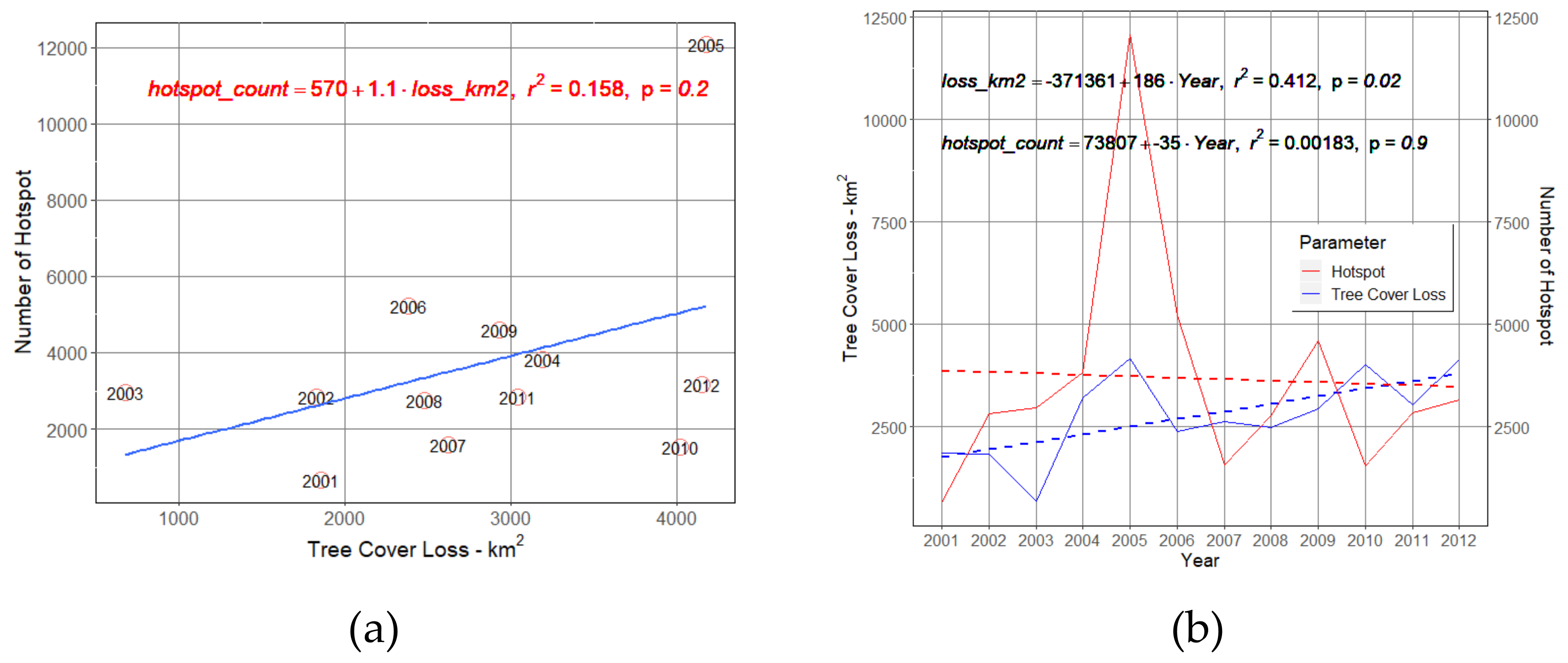
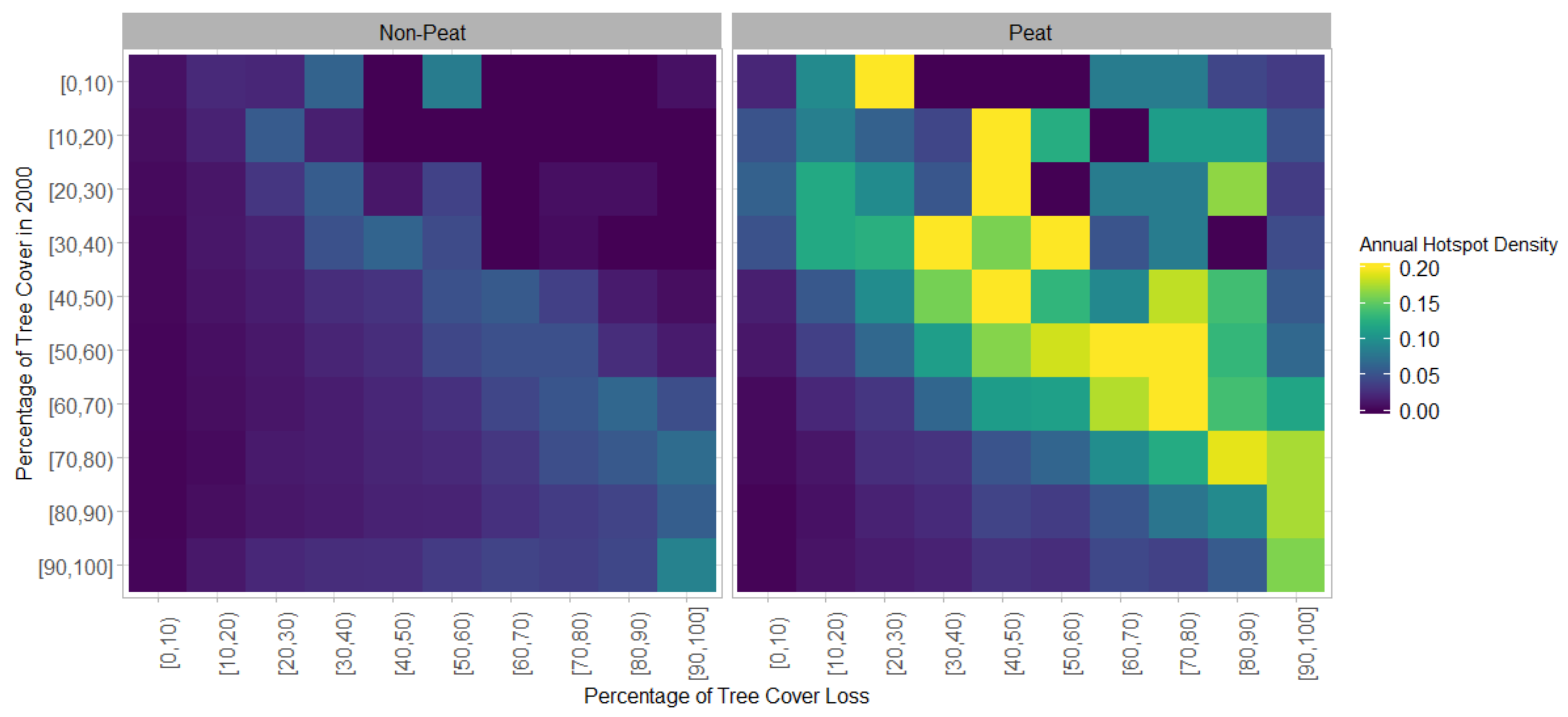
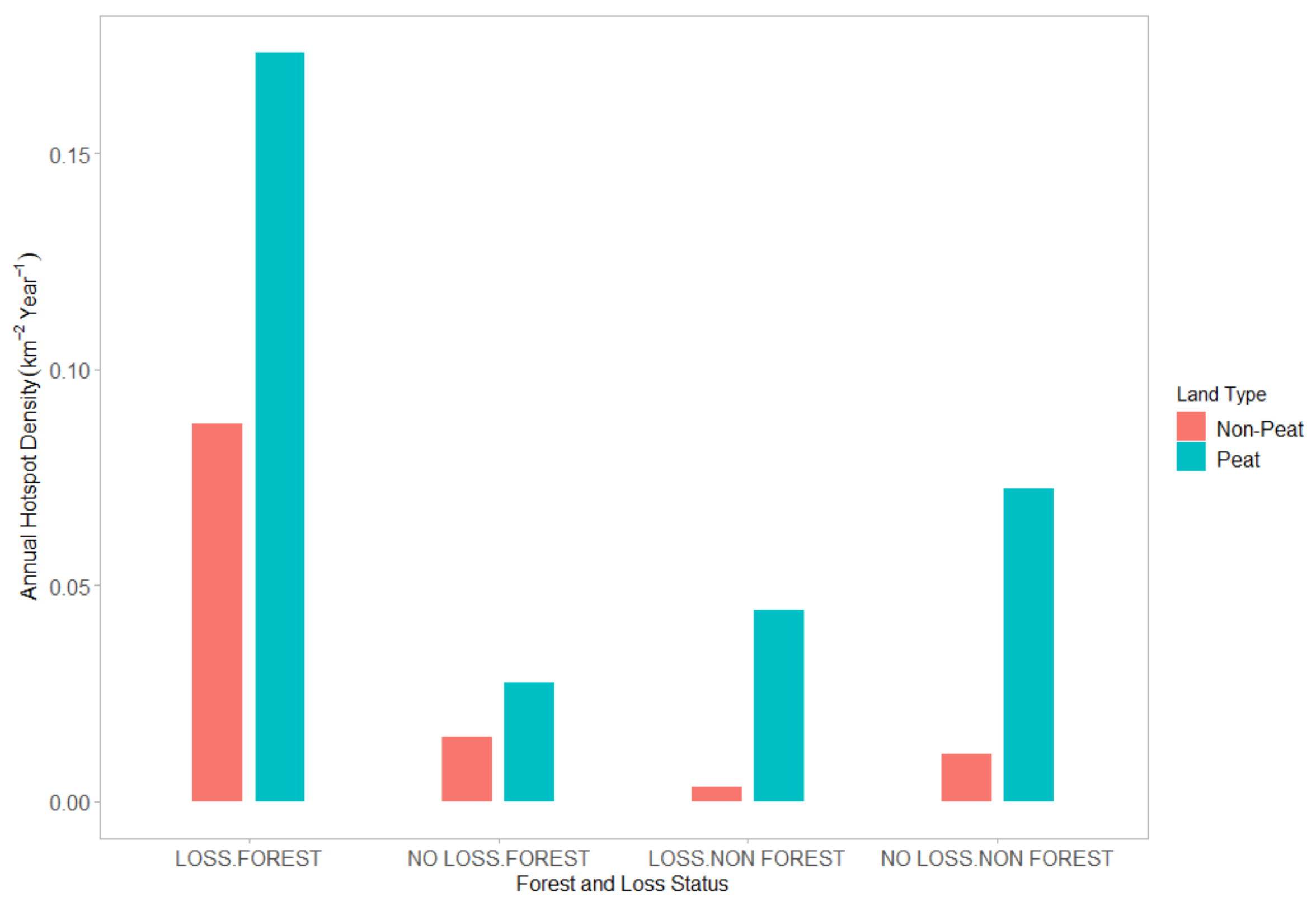
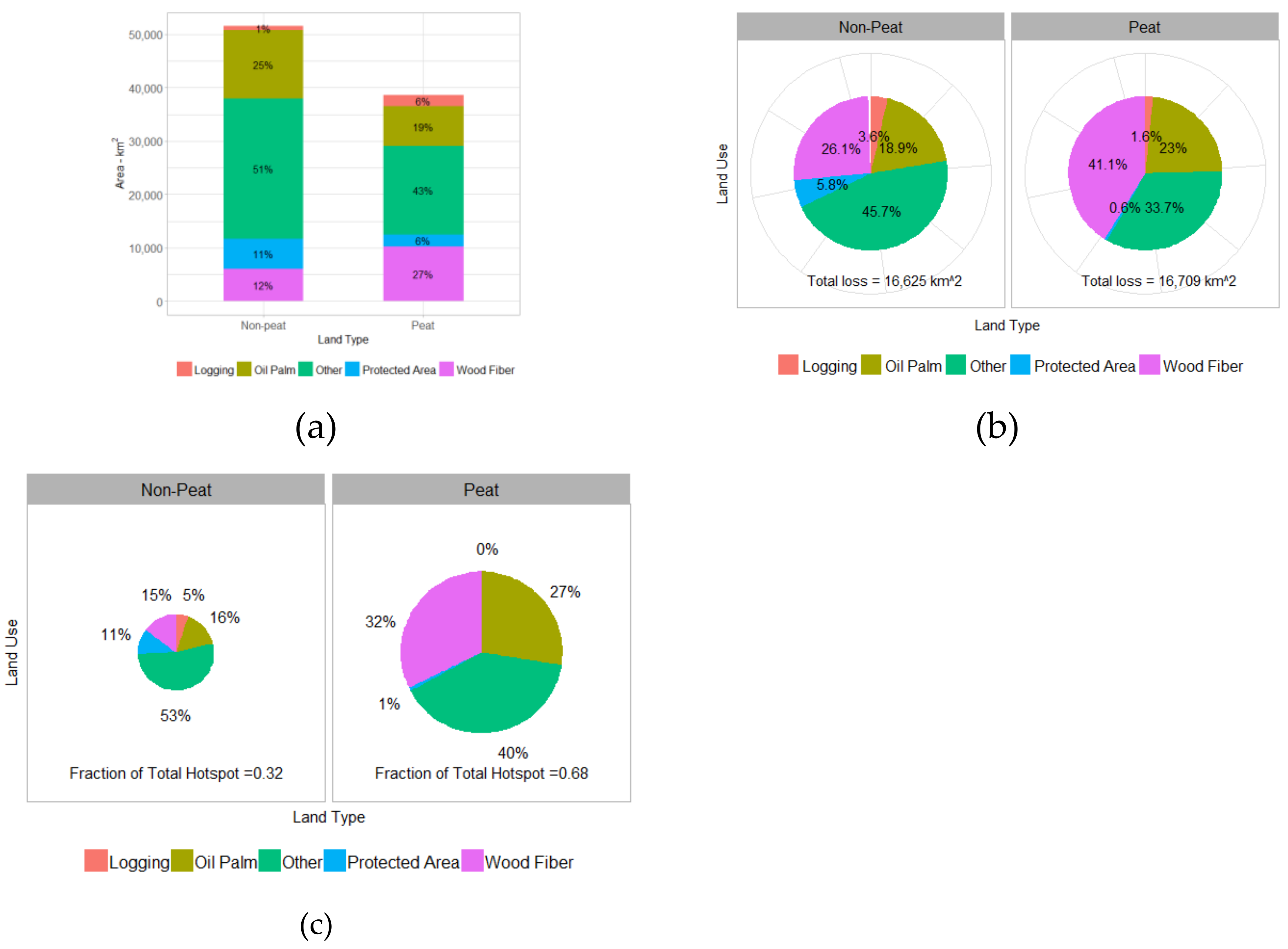
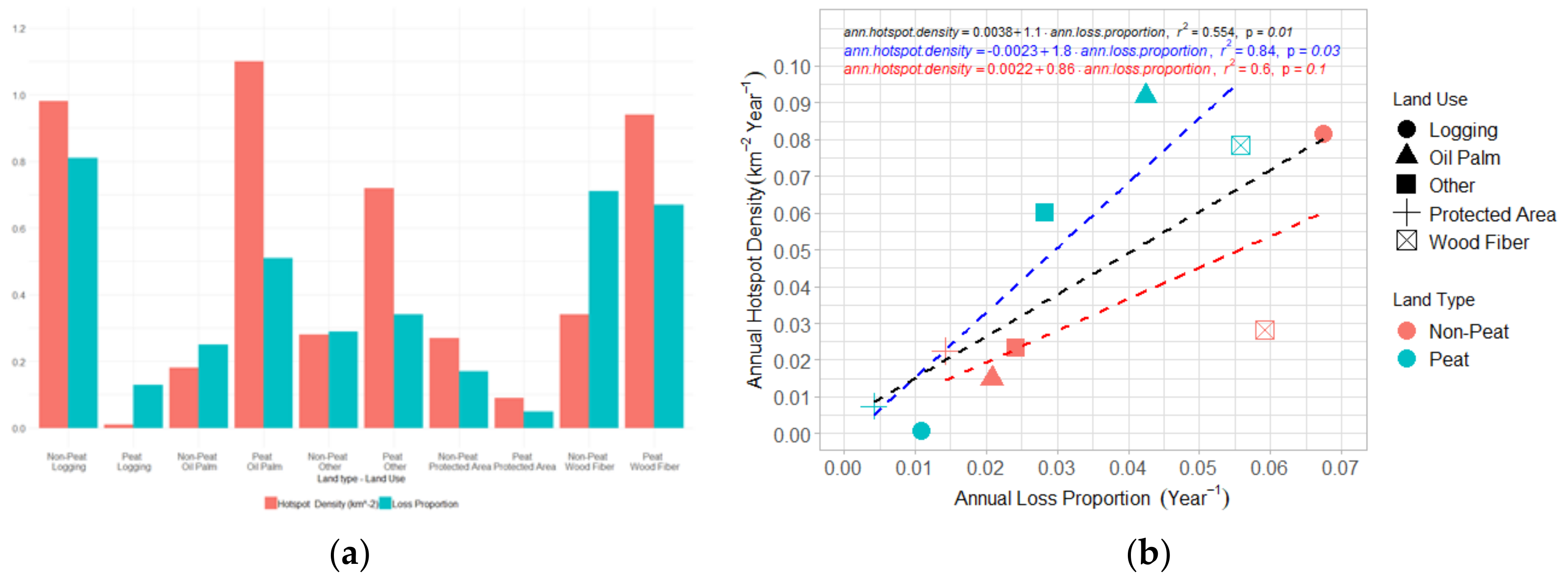
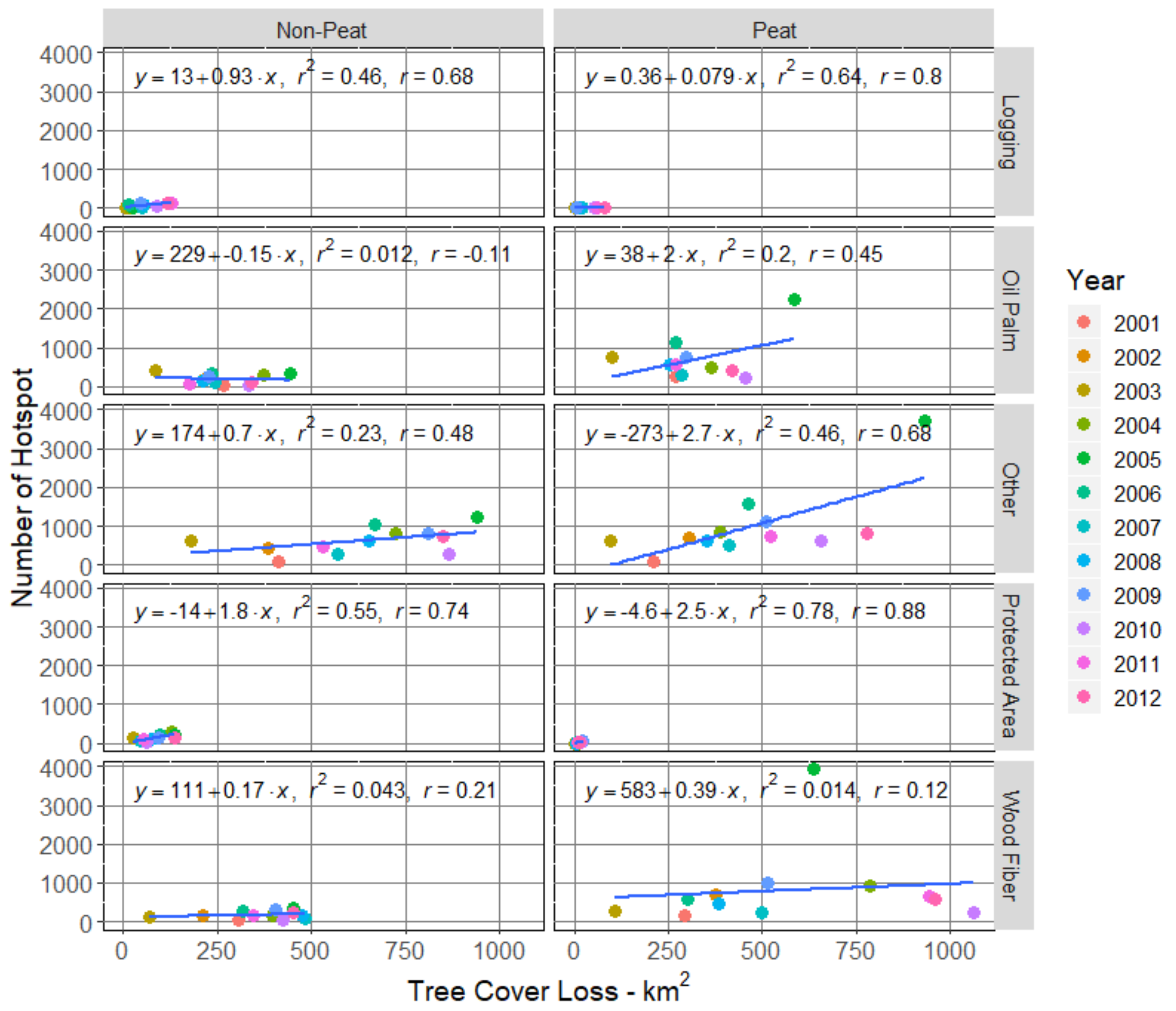
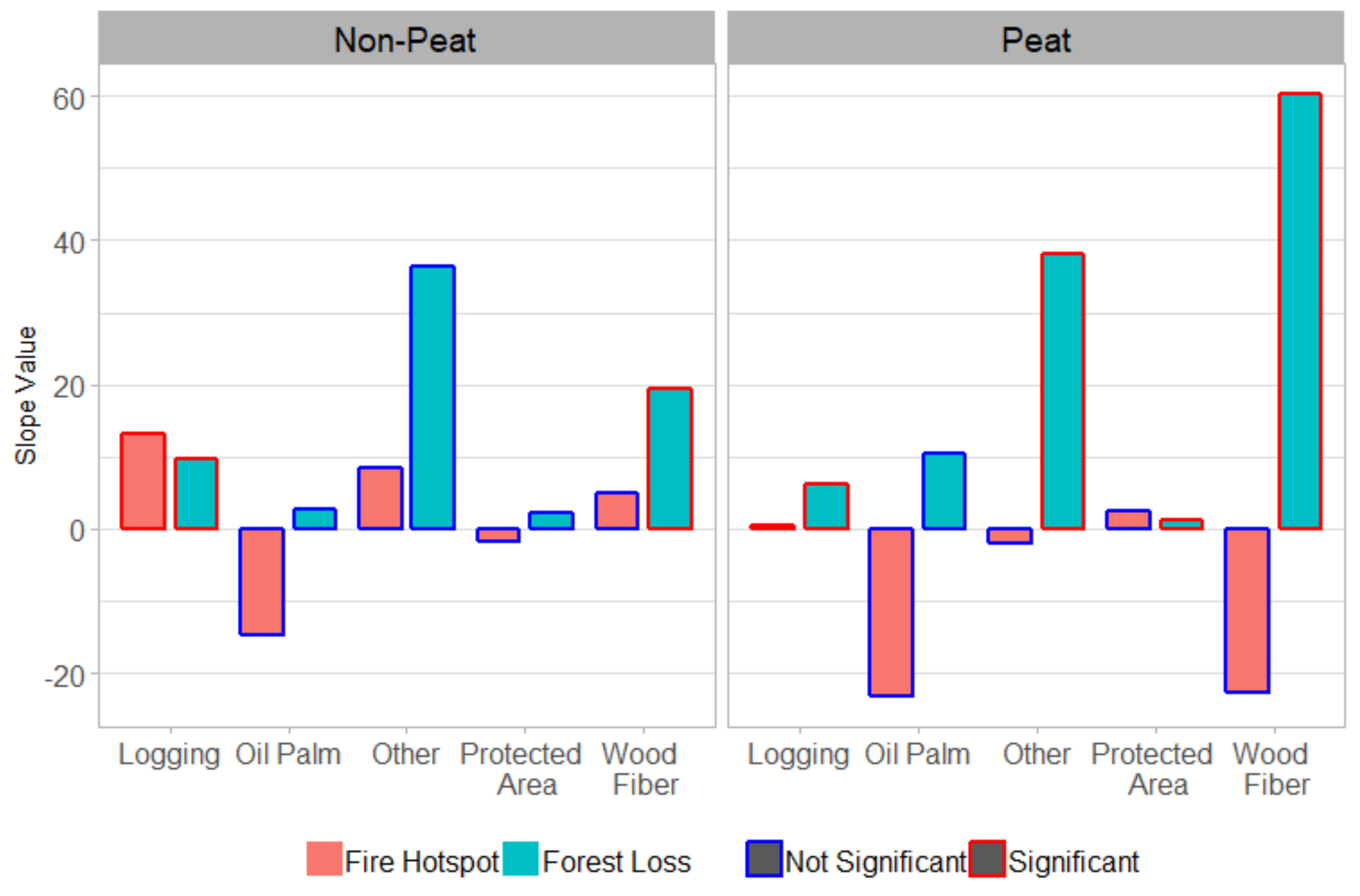
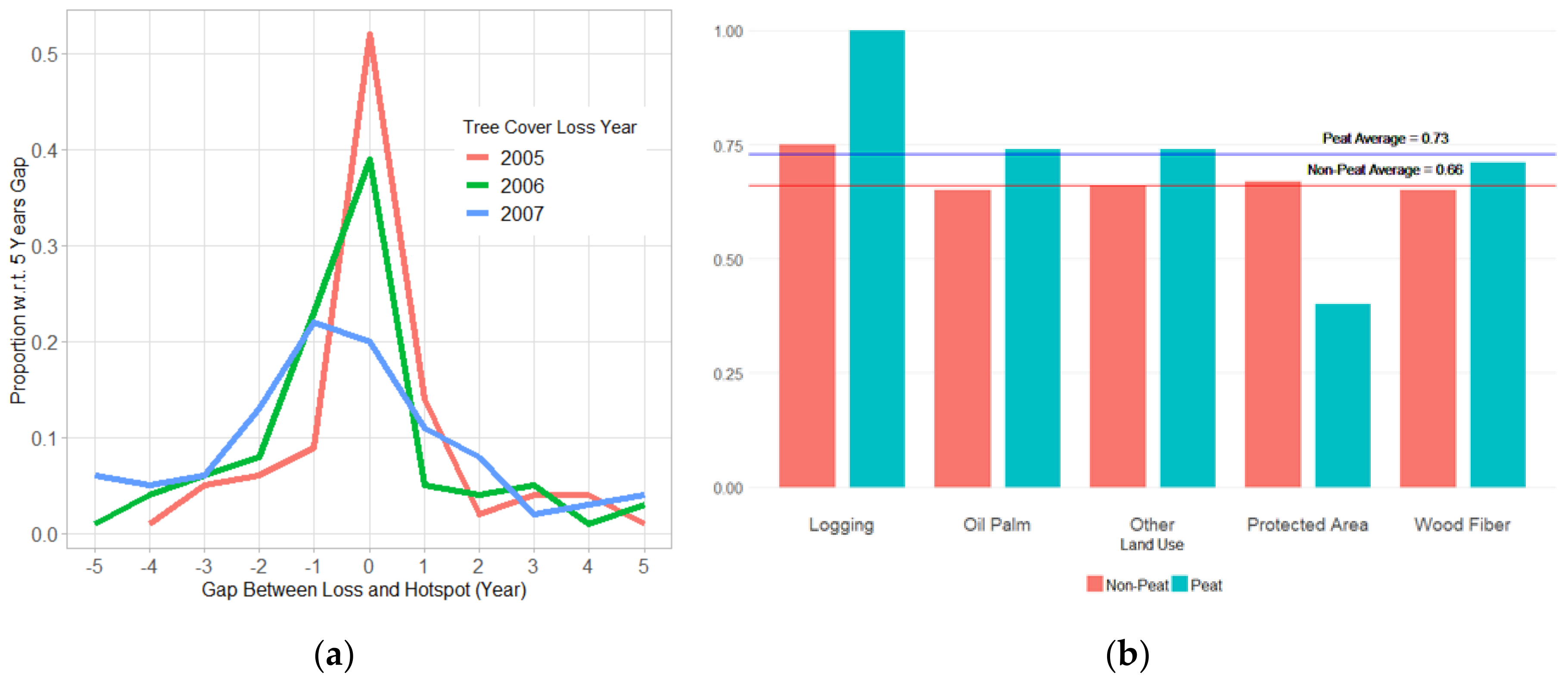
| Land Type | Area (km2) | Loss (km2) | Hotspot Count | Loss Proportion | Hotspot Density (km−2) | Hotspot Density per Loss (km−2) | Annual Loss Proportion (year−1) | Annual Hotspot Density (km−2 year−1) | Cells with Hotspot | Cells with Loss > 10% |
|---|---|---|---|---|---|---|---|---|---|---|
| a | b | c | d | e = c/b | f = d/b | g = d/c | h = e/12 | i = f/12 | j | k |
| Non-Peat | 51,492 | 16,625 | 14,006 | 0.32 | 0.27 | 0.84 | 0.027 | 0.02 | 7991 | 30,178 |
| Peat | 38,639 | 16,709 | 30,037 | 0.43 | 0.78 | 1.80 | 0.036 | 0.06 | 8592 | 23,633 |
| All Land Type | Σ = 90,131 | Σ = 33,334 | Σ = 44,043 | ∏ = sum(c)/sum(b) | ∏ = sum(d)/sum(b) | ∏ = sum(d)/sum(c) | ∏ = 0.031 | ∏ = 0.041 | Σ = 16,583 | Σ = 53,811 |
| =0.37 | =0.49 | =1.32 |
| Loss Status | Forest Status | Number Cells | Hotspot Total | Hotspot Density (km−2) | Annual Hotspot Density (km−2 year−1) |
|---|---|---|---|---|---|
| a | b | c | D | e = d/c | f = e/12 |
| All | Forest | 79844 | 40533 | 0.51 | 0.042 |
| All | Non forest | 12656 | 3510 | 0.28 | 0.023 |
| Loss | All | 14902 | 24663 | 1.65 | 0.138 |
| No loss | All | 77598 | 19380 | 0.25 | 0.021 |
| Loss | Forest | 14654 | 24554 | 1.68 | 0.14 |
| Loss | Non forest | 248 | 109 | 0.44 | 0.037 |
| No loss | Forest | 65190 | 15979 | 0.25 | 0.021 |
| Land Use | Area (km2) | Loss (km2) | Hotspot Count | Loss Proportion | Hotspot Density (km−2) | Hotspot Density per Loss (km−2) | Annual Loss Proportion (Year−1) | Annual Hotspot Density (km−2 Year−1) |
|---|---|---|---|---|---|---|---|---|
| a | b | c | d | e = c/b | f = d/b | g=d/c | h = e/12 | i = f/12 |
| Logging | 2860 | 864 | 737 | 0.3 | 0.26 | 0.85 | 0.025 | 0.022 |
| Oil palm | 20,266 | 6987 | 10,502 | 0.34 | 0.52 | 1.50 | 0.028 | 0.042 |
| Other | 42,745 | 13,213 | 19,334 | 0.31 | 0.45 | 1.46 | 0.026 | 0.038 |
| Protected | 7920 | 1065 | 1740 | 0.13 | 0.22 | 1.63 | 0.011 | 0.018 |
| Wood Fiber | 16,340 | 11,205 | 11,730 | 0.69 | 0.72 | 1.05 | 0.058 | 0.06 |
| Land Use | Land Type | Area (km2) | Loss (km2) | Hotspot Count | Tree Cover 2000 | Loss Prop. | Loss w.r.t. 2000 | Hotspot Density (km−2 Year−1) | Hotspot Density by Loss (km−2) | Cells with Hotspot | Cells with Loss > 10% |
|---|---|---|---|---|---|---|---|---|---|---|---|
| a | b | c | d | e | f | g | h | i | j | K | l |
| Logging | Non-peat | 726 | 591 | 711 | 735 | 0.81 | 0.8 | 0.98 | 1.2 | 374 | 662 |
| Logging | Peat | 2134 | 273 | 26 | 2199 | 0.13 | 0.12 | 0.01 | 0.1 | 25 | 480 |
| Oil palm | Non-peat | 12,769 | 3150 | 2259 | 10,075 | 0.25 | 0.31 | 0.18 | 0.72 | 1386 | 6324 |
| Oil palm | Peat | 7497 | 3837 | 8243 | 6449 | 0.51 | 0.59 | 1.1 | 2.15 | 2478 | 5652 |
| Other | Non-peat | 26,266 | 7589 | 7435 | 21,172 | 0.29 | 0.36 | 0.28 | 0.98 | 4195 | 15,707 |
| Other | Peat | 16,479 | 5624 | 11,899 | 16,070 | 0.34 | 0.35 | 0.72 | 2.12 | 3464 | 9182 |
| Protected Area | Non-peat | 5652 | 960 | 1534 | 5468 | 0.17 | 0.18 | 0.27 | 1.6 | 799 | 1717 |
| Protected Area | Peat | 2268 | 105 | 206 | 2276 | 0.05 | 0.05 | 0.09 | 1.97 | 92 | 227 |
| Wood fiber | Non-peat | 6080 | 4335 | 2067 | 5348 | 0.71 | 0.81 | 0.34 | 0.48 | 1237 | 5768 |
| Wood fiber | Peat | 10,260 | 6870 | 9663 | 10,052 | 0.67 | 0.68 | 0.94 | 1.41 | 2533 | 8092 |
| Summary | Σ = 90,131 | Σ = 33,334 | Σ = 44,043 | Σ = 79,844 | ∏ = sum (d)/sum(c) = 0.37 | ∏ = 0.425 | ∏ = sum(e)/sum(c) = 0.49 | ∏ = sum(e)/sum(d) = 1.32 | n = 16,583 | n = 53,811 |
| Loss Status (Number of Cells) | Forest Status | Fire Status | Number of Cells | % of Cells | Hotspot Sum | % of Hotspot |
|---|---|---|---|---|---|---|
| Loss (14,902) | Forest | Has fire | 6632 | 45% | 24,554 | 56% |
| Forest | No fire | 8022 | 55% | 0 | ||
| Sub-total (Loss-Forest): 14,654 | ||||||
| Non forest | Has fire | 45 | 18% | 109 | 0.2% | |
| Non forest | No fire | 203 | 82% | 0 | ||
| Sub-total (Loss-Non Forest): 248 | ||||||
| No Loss (77,598) | Forest | Has fire | 8439 | 13% | 15,979 | 36% |
| Forest | No fire | 56,751 | 87% | 0 | ||
| Sub-total (No loss – Forest): 65,190 | ||||||
| Non forest | Has fire | 1467 | 12% | 3401 | 8% | |
| Non forest | No fire | 10,941 | 88% | 0 | ||
| Sub-total (No loss – Non Forest): 12,408 | ||||||
| 92,500 | 44,043 | |||||
© 2019 by the authors. Licensee MDPI, Basel, Switzerland. This article is an open access article distributed under the terms and conditions of the Creative Commons Attribution (CC BY) license (http://creativecommons.org/licenses/by/4.0/).
Share and Cite
Adrianto, H.A.; Spracklen, D.V.; Arnold, S.R. Relationship Between Fire and Forest Cover Loss in Riau Province, Indonesia Between 2001 and 2012. Forests 2019, 10, 889. https://doi.org/10.3390/f10100889
Adrianto HA, Spracklen DV, Arnold SR. Relationship Between Fire and Forest Cover Loss in Riau Province, Indonesia Between 2001 and 2012. Forests. 2019; 10(10):889. https://doi.org/10.3390/f10100889
Chicago/Turabian StyleAdrianto, H. A., D. V. Spracklen, and S. R. Arnold. 2019. "Relationship Between Fire and Forest Cover Loss in Riau Province, Indonesia Between 2001 and 2012" Forests 10, no. 10: 889. https://doi.org/10.3390/f10100889





